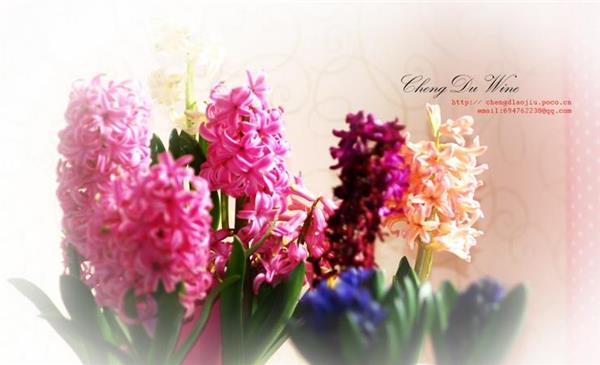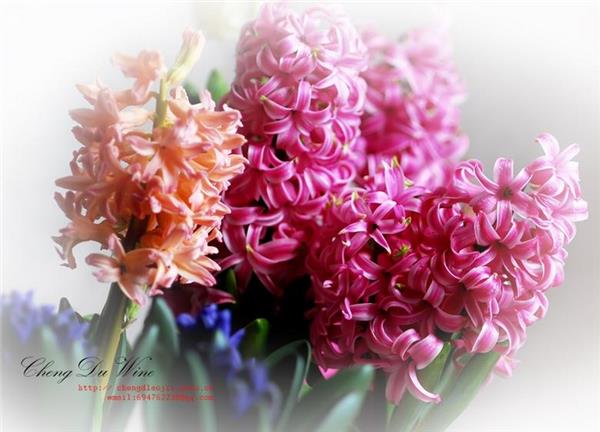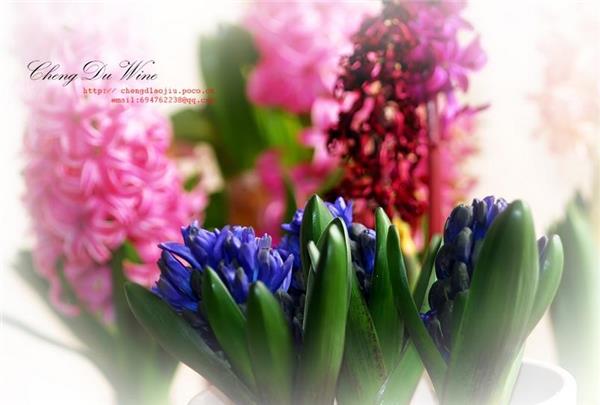A comprehensive interpretation of the breeding methods and matters needing attention of hyacinth
Hyacinth is a common species of hydroponic flowers and trees, color is very rich, loved by everyone, but many friends do not know how to raise this hyacinth, today to explain the hyacinth breeding methods and precautions.

If you want to know how to raise hyacinths, you should first understand the ecological habits of hyacinths.
Hyacinth likes warm and humid winter, cool and slightly dry summer, sunny or semi-cloudy environment. Like fertilizer, appropriate fertile, good drainage sandy loam, avoid too wet or sticky heavy soil.
Hyacinth is native to southern Europe. Likes cool, moist and sunny environments. Bulbs have the habit of dormancy in summer, rooting in autumn and winter, sprouting in early spring, flowering in March, and withering in early June. During the growth process, the root system grew best at 2~6℃. The optimum temperature for bud germination was 5~10℃, for leaf growth was 10~12℃, and for bud emergence and flowering was 15~18℃. The storage temperature of bulb was 20~28℃, the optimum temperature was 25℃, which was the best for flower bud differentiation.

The cultivation method of hyacinth in soil culture:
If your balls have grown roots and leaves and you prefer to grow them in soil, you can still plant them now.
1. Select healthy seed balls and plant them in loose culture soil.
2. The mixed substrate of peat + pearlite can be selected for culture soil.
3. The top 1/3 part of the ball should be exposed to the pot soil, which is more conducive to the growth of bulbs.
4. After planting, put it in a sunny place and keep the pot soil moist. The temperature of flower promotion is required to be 5-10℃. It should also be noted that hyacinth needs light and water very much. If the light is insufficient, or the winter is dry for a long time, it will lead to poor flowering; if you see that the flower stem is too short to elongate, you can put the potted flower 1 in the dark for several days to promote the stem and leaf to grow, and then turn to normal maintenance after the flower stem extends. Hyacinth has pink, purple, snow green, white, yellow, pink and other sample colors, the same breeding methods.
The cultivation method of hydroponics hyacinth:
1, water from the bulb to have 1-2 cm of space, do not immerse the bottom of the bulb water;
2, the water temperature should not be too high, preferably below 15℃;
3. Place the bulb on the bottle surface. After the roots are rooted, the water level can be lowered to the water surface that the roots can just touch, so that the roots can fully absorb oxygen and promote the growth of roots. After the root develops, the container can be covered with black cloth to further develop the ball heel. (Experiments have proved that roots grow best in dark environments) 4. Do not place bulbs in direct sunlight before germination;
5. When the buds of the bulbs grow to 5 cm, put them in the dark together with the bottles. After the roots are fully grown, move them to the south windowsill with warm and sufficient scattered light. Add water frequently to soak the bulbs.
6, leaves and flower buds grow out, the sun for 1-2 hours a day, so that its leaves and pedicels grow healthy, a day off a direction, do not make it due to phototaxis and bias to one side of growth, do not fertilize, the next year in March, April can open a bright and fragrant hyacinth.
7. Keep the temperature in your home at 17-20℃, you will enjoy the process of bud formation, growth and color development, but do not put it directly near the heat source, so that the beautiful hyacinth flower will extend the opening time.
8, keep the water in the bottle clean, change the water once a week, such as adding nutrient solution, depending on the turbidity of the water to determine the number of water changes.

Hyacinth breeding precautions
1. Selection of seed bulb: The nutrients required for hyacinth flowering mainly depend on the nutrients stored in the scales and stems. As long as the seed bulb with no damage to the epidermis, no excessive shrinkage of fleshy scales, hard and heavy, and full can bloom beautiful flowers.
2. Soil requirements: soil fertility, high organic matter content, good aggregate structure and pH value of 6~7 are required; culture soil can be prepared according to the ratio of moldy soil 5: garden soil 3: coarse sand 1.5: bone meal 0.5; before planting, chemicals such as formalin can be used. Under the condition of soil temperature of 10~15℃, the film shall be covered immediately after application on the soil surface. After 3 days of warm weather, the film shall be removed and planted after 1 day of air drying to keep the soil moist.
3, light: hyacinth only need more than 5000Lx, can maintain normal physiological activities. Too weak light will lead to thin plants, long stems, small flower buds, early flowers, yellow leaves, etc., which can be supplemented by incandescent lamps at about 1 meter; but too strong light will also cause leaves and petals to burn or shorten flowering period.
Temperature and humidity regulation: When the temperature is too high, even higher than 35℃, flower bud differentiation will be inhibited, abnormal growth, and blind flower rate will increase; if the temperature is too low, the flower bud will be frozen.
Soil humidity should be maintained between 60~70%, too high, root respiration is inhibited and easy to rot, too low, the ground part wilts, or even dies; air humidity should be maintained at about 80%, and can be increased by spraying, ground watering, ventilation and other methods to reduce humidity.

The introduction of hyacinth breeding methods and precautions is here today, I hope you like it!
The introduction of hyacinth breeding methods and precautions is here today, I hope you like it!
Related
- Wuhan Hospital Iron Tree Blooming Result Was Instantly Frightened by the Gardener Master
- Which variety of camellia is the most fragrant and best? Which one do you like best?
- What is the small blue coat, the breeding methods and matters needing attention of the succulent plant
- Dormancy time and maintenance management of succulent plants during dormancy
- Minas succulent how to raise, Minas succulent plant pictures
- What are the varieties of winter succulent plants
- How to raise succulent plants in twelve rolls? let's take a look at some experience of breeding twelve rolls.
- Attention should be paid to water control for succulent plants during dormant period (winter and summer)
- Watering experience of twelve rolls of succulent plants
- Techniques for fertilizing succulent plants. An article will let you know how to fertilize succulent plants.



